Punakaiki
Punakaiki is a small community on the West Coast of the South Island of New Zealand, between Westport and Greymouth. The community lies on the edge of the Paparoa National Park.
Punakaiki | |
|---|---|
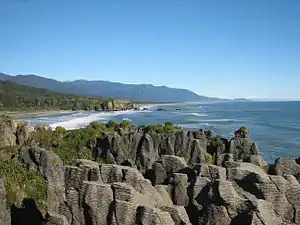 | |
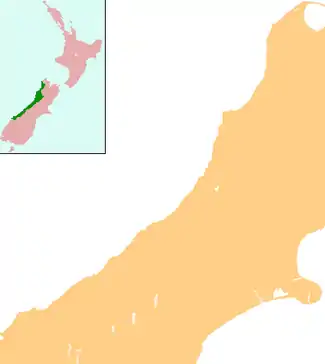 Punakaiki | |
| Coordinates: 42°6′30″S 171°20′10″E | |
| Country | New Zealand |
| Region | West Coast |
| District | Buller District |
| Electorates | West Coast-Tasman Te Tai Tonga |
The Pancake Rocks are a very popular tourist destination at Dolomite Point south of the main village.
Geology
The Pancake Rocks are a heavily eroded limestone area where the sea bursts through several vertical blowholes during high tides. Together with the 'pancake'-layering of the limestone (created by immense pressure on alternating hard and soft layers of marine creatures and plant sediments),[1] these form the main attraction of the area. The base of the limestone was laid down and formed between 25 million and 35 million years ago.[2]
Stylobedding is the name given to the process which formed the pancake layering. The current theory on how this happens is that following the limestone being buried up to kilometre below the seabed, it comes under pressure dissolution and the thinner layers of mud between the limestone are dissolved more quickly than the limestone, when exposed. This leaves the effect of the Pancake Rock layers.[2]
Wildlife and Conservation
Located on the edge of the Paparoa National Park, Punakaiki has a diverse range of birdlife and marine wildlife. Fur seals are seen on the rocks and Hector's dolphins close to the shore. Birds seen in the area include blue penguin, blue shag, black shag, Australasian gannet, white-faced heron, weka, kererū, tui, bellbird, fantail, grey warbler, and tomtit. The Westland petrel has its only mainland breeding colonies close by on the Barrytown flats.[2] These colonies were established in the middle of the 18th century.[3] The Department of Conservation designated the colony area as the Westland Petrel Special Protected Area in 1999 and access by the public is restricted.[4]
Limestone caves in the Punakaiki area preserved animal fossils dating back 25,000 years which help us visualize the fauna of the Otira Glaciation period. This fauna includes a variety of large and smalls (including moas), amphibians, reptiles, and potentially bats.[5]
Local conservation efforts including the Punakaiki Coastal Restoration Project which was started by the Department of Conservation, aluminum production company Rio Tinto, and Conservation Volunteers in 2009. The Project cover 40 ha. 4 km south of Punakaiki and is managed to restore the Sand Forest Flats and provide a forest to sea corridor.[6] The land is owned by the Department of Conservation and includes the last remaining Westland petrel breeding site on mainland New Zealand.[7]
Tourism
The Pancake Rocks are presently explorable by a number of walkways winding through the rock formations, parts of these wheelchair-accessible and others carved into stairways up and down the rock faces.[1] State Highway 6, the only through road on the West Coast, passes through the town. As well as visiting the rocks, tourists can stop and eat a stack of pancakes at a cafe across the road.
 Looking south from the pancake rocks
Looking south from the pancake rocks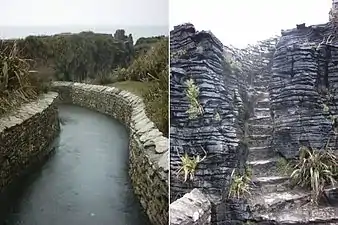 Walkways around the pancake rocks area
Walkways around the pancake rocks area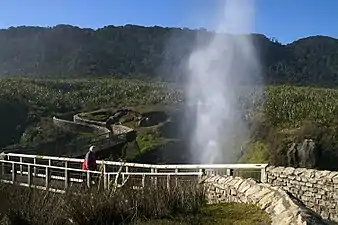 Walkway and blowhole
Walkway and blowhole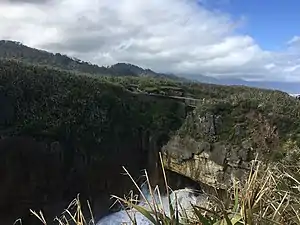 Underwater cave entrance that creates a spout effect at high tide at Pancake Rocks.
Underwater cave entrance that creates a spout effect at high tide at Pancake Rocks.
References
- Punakaiki Pancake Rocks and Blowholes (from the New Zealand Department of Conservation website)
- Wilson, Kerry-Jayne (2013). West Coast walking : a naturalist's guide. Christchurch, New Zealand: Canterbury University Press. pp. 163–168. ISBN 978-1-927145-42-5. OCLC 828664472.
- Holdaway, Richard N.; Hawke, David J.; Hyatt, Olivia M.; Wood, G. C. (2007). "Stable isotopic (δ 15 N, δ 13 C) analysis of wood in trees growing in past and present colonies of burrow‐nesting seabirds in New Zealand. I. δ 15 N in two species of conifer (Podocarpaceae) from a mainland colony of Westland petrels ( Procellaria westlandica ), Punakaiki, South Island". Journal of the Royal Society of New Zealand. 37 (2): 75–84. doi:10.1080/03014220709510537. ISSN 0303-6758.
- Stuart, A., Sullivan, B., Taylor, J., Wheatley, H., Calvert, R., Black, A., Fjagesund, T., Hermes, C., Anderson, O., Martin, R., McClellan, R., Stattersfield, A. "Westland Petrel Procellaria westlandica". Birdlife International. Retrieved 31 October 2020.CS1 maint: multiple names: authors list (link)
- Worthy, T. H.; Holdaway, R. N. (1993). "Quaternary fossil faunas from caves in the Punakaiki area, West Coast, South Island, New Zealand". Journal of the Royal Society of New Zealand. 23 (3): 147–254. doi:10.1080/03036758.1993.10721222. ISSN 0303-6758.
- "Punakaiki Coastal Restoration Project | West Coast, New Zealand". www.westcoast.co.nz. Retrieved 12 September 2020.
- Bowie, Mike, 1957-. Baseline survey for the Punakaiki Coastal Restoration Project. Mountier, Cathy,, Boyer, Stéphane,, Dickinson, Nick,, Rio Tinto (N.Z.),, Conservation Volunteers New Zealand,, Lincoln University (Canterbury, N.Z.). Department of Ecology. Christchurch, New Zealand. ISBN 978-0-86476-287-0. OCLC 1147925429.CS1 maint: multiple names: authors list (link)
External links
| Wikivoyage has a travel guide for Punakaiki. |
 Media related to Punakaiki at Wikimedia Commons
Media related to Punakaiki at Wikimedia Commons- Punakaiki - West Coast, New Zealand (tourism information from the Punakaiki Promotions Group)
- Limestone, Punakaiki (1st of 3) (entry on Te Ara: The Encyclopedia of New Zealand)

